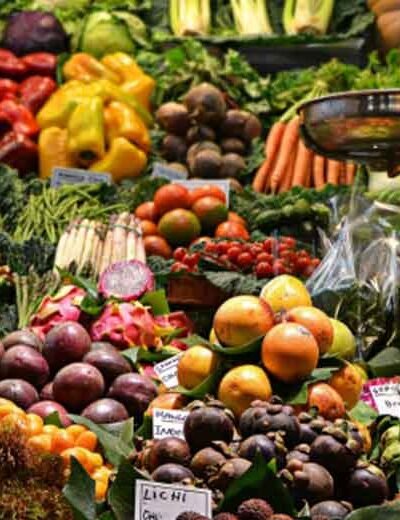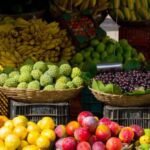Curious to know what’s next for fresh produce?
The fresh produce industry is evolving faster than ever. Whether its new technologies, changing consumer habits, or the latest TikTok trends, there’s a lot of exciting (and bewildering) change happening.
The thing is…
59% of consumers say they are willing to try new produce items than they used to. So, now is the perfect time to get informed on the future of the fresh produce industry.
Whether you are working with fruit and veg wholesalers or running your own fresh produce business, these are the trends set to impact the way we buy, sell, and consume fresh produce in the years to come.
Excited to get ahead of the game?
You’ll discover:
- Social Media Is Completely Changing How We Eat
- Technology Is Revolutionizing Fresh Produce Supply Chains
- Premium and Luxury Produce Is Having a Moment
- Health-Conscious Eating Is Driving Changes
Social Media Is Completely Changing How We Eat
Social media apps are single-handedly creating new fresh produce trends.
50% of diners report social media as a factor in where they dine. But the impact goes far beyond just restaurants. These social platforms are increasingly influencing grocery and pantry purchases, too.
Remember when Logan posted a video of his cucumber salad recipe a few months ago? It went viral. Sliced cucumbers dressed with Asian-inspired seasonings and vinegar. Cucumbers that most Americans would have never thought to use before. And suddenly, you couldn’t get cucumbers at the supermarket because they were sold out.
The interesting part is…
Fresh produce trends have gone far beyond just making salads and smoothies. Grocers are struggling to keep up with the variety of produce being featured in these social trends, which is causing a massive supply chain headache.
Videos showcasing produce going viral aren’t just:
- Raw carrot salads
- Frozen fruit shaved ice “snow cones”
- Using cottage cheese for dessert
- Candied fruits or tanghulu
Social media is a great place to source the latest fresh produce trends. Pay close attention to what home chefs are creating. The average TikTok user is more likely to influence fresh produce purchases than a famous celebrity chef.
Technology Is Revolutionizing Fresh Produce Supply Chains
Now for the really good stuff.
Technology is coming to save fresh produce. Advanced innovations for supply chain tech are addressing challenges that have stymied the industry for decades.
Here’s what’s exciting:
Blockchain traceability is providing consumers more information than ever before. You can now use your smartphone to scan a QR code on the produce and see exactly where it came from.
AI-based demand forecasting enables retailers to stock precisely the right amount, at just the right time, leading to fewer shortages and less food waste.
IoT sensors track temperature and humidity throughout the supply chain, so delicate produce arrives to market in peak condition.
Controlled environment agriculture is bringing local fresh produce production closer to consumers. Vertical farms and indoor greenhouses are showing up near many urban centers.
The best news is that all this technology is helping make fresh produce more affordable for consumers.
Premium and Luxury Produce Is Having a Moment
Ok, you might not have seen this one coming…
Luxury and premium produce has been having a moment lately. Expensive fruits and vegetables with exotic names and flashy packaging are grabbing consumers’ attention.
Think Sapūrana mangoes and Oishii strawberries. These items are more expensive, but they have a compelling story that consumers are finding valuable.
This is more than just splurging on a pricey bag of fruit. Consumers are choosing to purchase more expensive produce to fulfill several other desires, such as:
- Seeking unique varieties
- The backstory
- Gift-worthy items
- Food that looks impressive on social media
The shift reflects a larger trend in consumer behavior around more mindful consumption. Many are choosing to purchase less produce but to spend more money on the items they do buy.
But it’s not just about rich consumers splurging.
The “premiumization” trend is trickling down through other price points, as even budget consumers are occasionally willing to splurge a bit on something luxurious.
Health-Conscious Eating Is Driving Changes
The shift to healthier eating is transforming fresh produce in big ways.
Look no further than the fact that 78% of Gen Z and 75% of millennials are eating more fresh produce than they were a year ago. This isn’t a temporary fad, either. Younger consumers are altering their entire approach to food.
The drivers include:
- Greater recognition that nutrition affects overall health
- Social media promoting “clean eating” lifestyles
- Rising interest in plant-based eating
- Understanding of the role of food in mental health
The food as medicine movement is gaining real traction. Consumers are no longer only purchasing fresh produce for its flavor. They are also seeking out foods that help them achieve specific health goals.
Functional foods are on the rise. Consumers are actively pursuing produce known to be high in antioxidants and other healthy ingredients. This is fueling demand for suppliers to provide more detailed nutrition information.
Sustainability and Transparency Are Non-Negotiable
Ok, here’s the fun part.
Consumers today not only want fresh produce; they also want to know everything about how it was grown and produced.
This is leading to sweeping changes across the industry:
Supply chain transparency is becoming the new baseline. Consumers expect granular information on growing practices, conditions for workers, and the environmental impact of growing practices.
Local and regional sourcing is increasing as people try to limit food miles and support local businesses. Farm-to-table was a foodie fad that has now become an everyday consumer trend.
Organic and sustainably-grown produce continues to take market share. Consumers are demanding regenerative agriculture, carbon-neutral growing practices, and ethical labor practices.
The challenge for suppliers?
Meeting consumers’ new demands while also remaining competitively priced and ensuring a consistent supply.
Global Trade Is Reshaping Produce Availability
Something interesting is happening in global fresh produce trade.
The percentage of U.S. fresh fruit availability from imports grew from 50% to 60% between 2007 and 2021. In fresh vegetables, it increased from 20% to 38%. Produce globalization is leading to the year-round availability of traditional seasonal items and access to exotic items consumers may never have tried before.
But here’s the catch:
While globalization increases consumer choice, there is also a countercurrent toward hyperlocal sourcing and production. Urban farming and regional distribution centers are bringing certain items closer to consumers than ever before.
It is a dual trend that creates interesting opportunities for savvy suppliers to balance global sources for exotic items and hyperlocal and regional production for staples and seasonal specialties.
Wrapping Up Fresh Trends
So, that’s it for this quick overview of what’s in store for fresh produce. The future of fresh produce trends is not something that can be predicted. Social media can change demand overnight, and technology is helping to solve some of the oldest industry supply chain problems.
Consumers are savvier and more demanding than ever before. The winning players in this new industry will be those who:
- Track social media and consumer behavior closely
- Are willing to invest in the new supply chain technologies
- Can offer premium products without leaving consumers behind
- Prioritize sustainability but not at the expense of quality and affordability
- Stay nimble and be able to pivot quickly
The fresh produce industry is entering its most exciting, dynamic period to date. Those that can see the future and act on the trends will succeed. But those who ignore the changing landscape will quickly fall by the wayside.
It’s not a question of whether these trends will continue to occur, but rather how quickly you will be able to keep up with them. The future of fresh produce is happening right now, and it’s more exciting than anyone could have imagined.






Leave a Reply